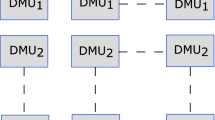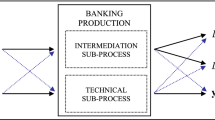Abstract
We use a novel three-stage network data envelopment analysis (DEA) model (based on production, intermediation, and revenue generation operations) with bootstrapping to evaluate the performance of 14 of the largest Canadian credit unions for the period 2007–2017 and the impact of various events on this performance. For each analysis, we contrast the results of the network DEA with those of a black box DEA. We show that the former provides more insightful information regarding the sources of the inefficiencies. We first found that while overall, the credit unions showed high-efficiency ratios, there is room for improvement, especially for the production sub-process. Moreover, the efficiency of individual credit unions is not consistent across the three different stages. Through the years 2007–2017, the credit union system exhibits a relatively sharp decline in its efficiency, mainly due to managerial issues at the revenue generation stage. Our analyses show that the various stages of Canadian credit union operations have been affected by the 2007–2009 financial crisis, the low policy interest rates that occurred in the following years, and the fact that in Canada, the federal government has eliminated the discount on the federal tax rate. The credit unions can improve their performance at the different stages by exploring Fintech Solutions to reduce their operating costs, seeking a better mix of loans and securities investments, and improving their interest and saving rate settings.







Similar content being viewed by others
Change history
08 May 2020
A Correction to this paper has been published: https://doi.org/10.1007/s10479-020-03628-2
References
Aggelopoulos, E., & Georgopoulos, A. (2017). Bank branch efficiency under environmental change: A bootstrap DEA on monthly profit and loss accounting statements of Greek retail branches. European Journal of Operational Research, 261(3), 1170–1188.
Akther, S., Fukuyama, H., & Weber, W. L. (2013). Estimating two-stage network slacks-based inefficiency: An application to Bangladesh banking. Omega, 41(1), 88–96.
Assaf, A. G., Barros, C., & Sellers-Rubio, R. (2011). Efficiency determinants in retail stores: A Bayesian framework. Omega, 39(1), 283–292.
Balk, B. M. (2001). Scale efficiency and productivity change. Journal of Productivity Analysis, 15(3), 159–183.
Banker, R. D., Charnes, A., & Cooper, W. W. (1984). Some models for estimating technical and scale efficiencies in data envelopment analysis. Management Science, 30(9), 1078–1092.
Banker, R. D., Charnes, A., Cooper, W. W., & Maindiratta, A. (1988). A comparison of DEA and translog estimates of production frontiers using simulated observations from a known technology. In A. Dogramaci & R. Färe (Eds.), Applications of modern production theory: Efficiency and productivity (pp. 33–55). Dordrecht: Springer.
Banker, R. D., Conrad, R. F., & Strauss, R. P. (1986). A comparative application of data envelopment analysis and translog methods: An illustrative study of hospital production. Management Science, 32(1), 30–44.
Borodak, D. (2007). Les outils d’analyse des performances productives utilisés en économie et gestion: la mesure de l’efficience technique et ses déterminants. (Cahiers de recherches, No. 5/2007). Clermont-Ferrand: Groupe ESC CLERMONT.
Bowlin, W. F., Charnes, A., Cooper, W. W., & Sherman, H. D. (1984). Data envelopment analysis and regression approaches to efficiency estimation and evaluation. Annals of Operations Research, 2(1), 113–138.
CCUA. (2017). 2017 Community and economic impact Report. Retrieved on December 1, 2018, from https://ccua.com/news/canadian-credit-unions-celebrate-positive-impact-on-community-and-economy-on-international-credit-union-day/.
CCUA. (2018). The largest 100 credit unions/caisses populaires (Second Quarter 2018). Retrieved on December 1, 2018, from https://ccua.com/about-credit-unions/facts-and-figures/largest-100-credit-unions/.
Charnes, A., Cooper, W. W., Lewinet, A. Y., & Seiford, L. M. (1995). Data envelopment analysis: Theory, Methodology and Applications. Boston: Kluwer Academic Publishers.
Charnes, A., Cooper, W. W., & Rhodes, E. (1978). Measuring the efficiency of decision-making units. European Journal of Operational Research, 2(6), 429–444.
Chen, Y., Cook, W. D., & Lim, S. (2019). Preface: DEA and its applications in operations and data analytics. Annals of Operations Research, 278(1–2), 1–4.
Chen, P. C., & Lu, Y. H. (2015). The impact of reform on the production efficiency of Taiwan’s farmers’ credit unions: An application of a two-stage production system with undesirable outputs. Academia Economic Papers, 43(1), 81.
Cook, W. D., & Seiford, L. M. (2009). Data envelopment analysis (DEA)—thirty years on. European Journal of Operational Research, 192(1), 1–17.
Daraio, C., & Simar, L. (2007). The measurement of efficiency. In C. Daraio & L. Simar (Eds.), Advanced robust and nonparametric methods in efficiency analysis. New York: Springer.
Deloitte. (2013). 2013 federal budget—impact on credit unions. Retrieved on February 22, 2019, from https://www2.deloitte.com/content/dam/Deloitte/ca/Documents/tax/ca-en-tax-2013-federal-budget-impact-on-credit-unions.pdf.
DeYoung, R., & Rice, T. (2004). How do banks make money? A variety of business strategies. Economic Perspectives-Federal Reserve Bank of Chicago, 28(4), 52–67.
Emrouznejad, A., & Yang, G. L. (2018). A survey and analysis of the first 40 years of scholarly literature in DEA: 1978–2016. Socio-Economic Planning Sciences, 61(2), 4–8.
Emrouznejad, A., Parker, B., & Tavares, G. (2008). Evaluation of research in efficiency and productivity: A survey and analysis of the first 30 years of scholarly literature in DEA. Journal of Socio-Economic Planning Sciences, 42(1), 151–157.
Färe, R., Grosskopf, S., & Whittaker, G. (2007). Network dea. In J. Zhu & W. D. Cook (Eds.), Modeling data irregularities and structural complexities in data envelopment analysis (pp. 209–240). Boston, MA: Springer.
Folan, P., & Browne, J. (2005). A review of performance measurement: Towards performance management. Computers in Industry, 56(7), 663–680.
Fried, H. O., Lovell, C. K., & Eeckaut, P. V. (1993). Evaluating the performance of US credit unions. Journal of Banking & Finance, 17(2–3), 251–265.
Fried, H. O., Lovell, K. C. A., & Schmidt, S. S. (2008). The measurement of productive efficiency and productivity growth. Oxford: Oxford University Press.
Fried, H. O., Lovell, C. K., & Turner, J. A. (1996). An analysis of the performance of university-affiliated credit unions. Computers & Operations Research, 23(4), 375–384.
Fu, H. P., Chang, T. H., Shieh, L., Lin, A. F., & Lin, S. W. (2015). Applying DEA–BPN to enhance the explanatory power of performance measurement. Systems Research and Behavioral Science, 32(6), 707–720.
Fukuyama, H., & Matousek, R. (2017). Modelling bank performance: A network DEA approach. European Journal of Operational Research, 259(2), 721–732.
Fukuyama, H., & Weber, W. L. (2015). Measuring Japanese bank performance: A dynamic network DEA approach. Journal of Productivity Analysis, 44(3), 249–264.
Gambacorta, L. (2008). How do banks set interest rates? European Economic Review, 52(5), 792–819.
Glass, J. C., McKillop, D. G., & Rasaratnam, S. (2010). Irish credit unions: Investigating performance determinants and the opportunity cost of regulatory compliance. Journal of Banking & Finance, 34(1), 67–76.
Holod, D., & Lewis, H. F. (2011). Resolving the deposit dilemma: A new DEA bank efficiency model. Journal of Banking & Finance, 35(11), 2801–2810.
Joo, S. J., Stoeberl, P. A., Liao, K., & Ke, K. (2017). Measuring the comparative performance of branches of a credit union for internal benchmarking. Benchmarking: An International Journal, 24(6), 1663–1674.
Kao, C. (2014). Network data envelopment analysis: A review. European Journal of Operational Research, 239(1), 1–16.
Kao, C. (2017). Network data envelopment analysis (Vol. 10, p. 978-3)., International series in operations research & management science Boston: Springer.
Leclerc, A., & Fortin, M. (2009). Économies d’échelle et de gamme dans les coopératives de services financiers: une approche non paramétrique (DEA). L’Actualité économique, 85(3), 263–282.
Martínez-Campillo, A., & Fernández-Santos, Y. (2017). What about the social efficiency in credit cooperatives? Evidence from Spain (2008–2014). Social Indicators Research, 131(2), 607–629.
Martínez-Campillo, A., Fernández-Santos, Y., & del Pilar Sierra-Fernández, M. (2018). How well have social economy financial institutions performed during the crisis period? Exploring financial and social efficiency in Spanish credit unions. Journal of Business Ethics, 151(2), 319–336.
Marwa, N., & Aziakpono, M. (2016). Technical and scale efficiency of Tanzanian saving and credit cooperatives. The Journal of Developing Areas, 50(1), 29–46.
McAlevey, L., Sibbald, A., & Tripe, D. (2010). New Zealand credit union mergers. Annals of Public and Cooperative Economics, 81(3), 423–444.
McKillop, D., French, D., Quinn, B., Sobiech, A. L., & Wilson, J. O. S. (2020). Cooperative financial institutions: A review of the literature. Centre for responsible banking & finance working paper, (20-0X).
McKillop, D., & Wilson, J. O. (2011). Credit unions: A theoretical and empirical overview. Financial Markets, Institutions & Instruments, 20(3), 79–123.
Murdock, C. W. (2011). The Dodd-Frank Wall Street reform and consumer protection act: What caused the financial crisis and will Dodd-Frank prevent future crises. SMUL Review, 64, 1243.
Paradi, J. C., Sherman, H. D., & Tam, F. K. (2017). Data envelopment analysis in the financial services industry: A guide for practitioners and analysts working in operations research using DEA (Vol. 266). Berlin: Springer.
Pille, P., & Paradi, J. C. (2002). Financial performance analysis of Ontario (Canada) credit unions: An application of DEA in the regulatory environment. European Journal of Operational Research, 139(2), 339–350.
Ralston, D., Wright, A., & Garden, K. (2001). Can mergers ensure the survival of credit unions in the third millennium? Journal of Banking & Finance, 25(12), 2277–2304.
Sarkis, J. (2007). Preparing your data for DEA. In J. Zhu & W. D. Cook (Eds.), Modeling data irregularities and structural complexities in data envelopment analysis. Boston: Springer.
Sharma, D., Sharma, A. K., & Barua, M. K. (2013). Efficiency and productivity of banking sector: A critical analysis of literature and design of conceptual model. Qualitative Research in Financial Markets, 5(2), 195–224.
Simar, L., & Wilson, P. W. (1998). Sensitivity analysis of efficiency scores: How to bootstrap in nonparametric frontier models. Management Science, 44(1), 49–61.
Simar, L., & Wilson, P. W. (2000). Statistical inference in nonparametric frontier models: The state of the art. Journal of Productivity Analysis, 13(1), 49–78.
Simar, L., & Wilson, P. W. (2011). Two-stage DEA: Caveat emptor. Journal of Productivity Analysis, 36, 205–218. https://doi.org/10.1007/s11123-011-0230-6.
Simeone, W. J., & Li, H. C. (1997). Credit union performance: An evaluation of Rhode Island institutions. American Business Review, 15(1), 99–105.
Sousa de Abreu, E., Kimura, H., Araújo Neto, L. M. D., & Peng, Y. (2018). Efficiency of the Brazilian credit unions: A joint evaluation of economic and social goals. Latin American Business Review, 19(2), 107–129.
Toma, P., Miglietta, P. P., Zurlini, G., Valente, D., & Petrosillo, I. (2017). A non-parametric bootstrap-data envelopment analysis approach for environmental policy planning and management of agricultural efficiency in EU countries. Ecological Indicators, 83(1), 132–143.
Tsionas, E. G., & Mamatzakis, E. C. (2017). Adjustment costs in the technical efficiency: An application to global banking. European Journal of Operational Research, 256(2), 640–649.
Wamba, S. F., Gunasekaran, A., Dubey, R., & Ngai, E. W. (2018). Big data analytics in operations and supply chain management. Annals of Operations Research, 270(1–2), 1–4.
Wang, K., Huang, W., Wu, J., & Liu, Y. N. (2014a). Efficiency measures of the Chinese commercial banking system using an additive two-stage DEA. Omega, 44(1), 5–20.
Wang, W. K., Lu, W. M., & Liu, P. Y. (2014b). A fuzzy multi-objective two-stage DEA model for evaluating the performance of US bank holding companies. Expert Systems with Applications, 41(9), 4290–4297.
Worthington, A. C. (2001). Efficiency in pre-merger and post-merger non-bank financial institutions. Managerial and Decision Economics, 22(8), 439–452.
Zéghal, D., & El Aoun, M. (2016). Enterprise risk management in the US banking sector following the financial crisis. Modern Economy, 7(4), 494–513.
Author information
Authors and Affiliations
Corresponding author
Additional information
Publisher's Note
Springer Nature remains neutral with regard to jurisdictional claims in published maps and institutional affiliations.
Rights and permissions
About this article
Cite this article
Dia, M., Takouda, P.M. & Golmohammadi, A. Assessing the performance of Canadian credit unions using a three-stage network bootstrap DEA. Ann Oper Res 311, 641–673 (2022). https://doi.org/10.1007/s10479-020-03612-w
Published:
Issue Date:
DOI: https://doi.org/10.1007/s10479-020-03612-w




